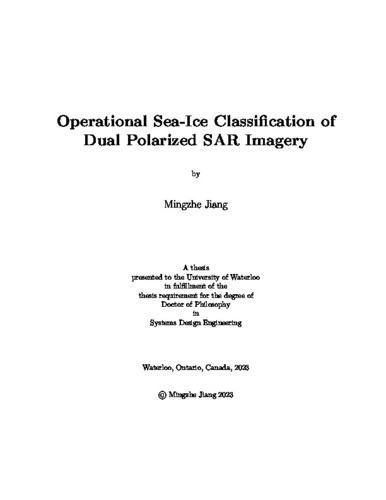| dc.description.abstract | Mapping sea ice in polar regions is crucial for research and operational applications, such as environmental modeling and ship navigation. Synthetic aperture radar (SAR) offers a dependable and efficient means of monitoring sea ice under various weather conditions and operational scenarios. Presently, national ice services, such as the Canadian Ice Service (CIS), rely on experienced ice analysts to manually interpret SAR imagery and generate ice charts. Although these charts have been in use for decades, they possess several shortcomings. Manual interpretation necessitates significant expert resources and introduces human bias, and the charts only provide a region-based approximation of ice conditions. Consequently, automated sea-ice classification systems are highly desirable, aiming to accurately label each pixel in SAR imagery with the corresponding sea-ice type.
Addressing the challenges in sea ice classification, such as intra- and inter-class variance, has proven difficult for single-model-based systems due to the limited spatial and contextual information captured. This thesis introduces sea ice classification methods comprising two primary stages: unsupervised segmentation to generate homogeneous regions, and labeling to assign each homogeneous region an appropriate label.
Two innovative methods that directly combine segmentation and labeling for automated sea ice classification are presented. Firstly, a convolutional neural network (CNN) based approach, inspired by the rapid advancements in deep-learning architectures, is developed to differentiate between sea ice and open water. A regional pooling layer is introduced to harness the spatial features learned through labeling and the contextual information extracted via segmentation. Since CNN models necessitate extensive labeled samples, which are scarce for various ice types, a random-forest-based method trained on limited labeled samples is formulated. Texture features are initially extracted from each pixel and then combined with an energy function to assign pixel-level labels of sea ice types to homogeneous regions.
Acknowledging the limitations of direct integration, including the need for extensive labeled training samples and the inherent issue of CNN's limited receptive field, a semi-supervised graph convolutional network (GCN) based method is proposed for operational sea ice classification. A CNN is initially employed to extract features from each node generated by segmentation, followed by the construction of a graph based on the feature vector and the statistical relation between nodes. Lastly, a GCN is designed to propagate local spatial and contextual information to the global level, facilitating the classification of unlabeled nodes in the graph. As a semi-supervised method, the proposed network requires labeled samples from the processing scene as initiating nodes. In comparison to fully-supervised methods, the GCN-based approach substantially reduces misclassifications of sea ice types due to the absence of prior knowledge.
The classification outcomes reveal that the proposed methods demonstrate promising performance in their respective categories and surpass other state-of-the-art sea-ice classification methods in terms of both numerical accuracy and visual interpretation. Furthermore, the GCN-based method incorporates human supervision to enhance the quality of the produced sea-ice maps, which exhibit high consistency with ice charts released by ice analysts. | en |

